Complex Care Needs: A Nursing Care Plan for Ravi Maharaj's Case Study
VerifiedAdded on 2023/04/23
|27
|6250
|297
Case Study
AI Summary
This case study presents a comprehensive nursing care plan for Ravi Maharaj, a 59-year-old patient with end-stage liver disease requiring palliative care at home. The analysis identifies key nursing problems, including anxiety related to spiritual concerns and impending death, as well as pain associated with ascites. The care plan utilizes the Roper Logan and Tierney model of activities of daily living and the APIE approach, prioritizing anxiety and pain management. Pharmacological and non-pharmacological interventions are critically evaluated, with SMART goals designed to address physical and mental well-being through a multidisciplinary team approach. The assessment framework is appraised, and alternative tools like the Hospital Anxiety and Depression Scale (HADS) and PQRST pain assessment are considered. The plan emphasizes a family-centered approach to address social isolation and support Ravi's overall well-being during this challenging time.
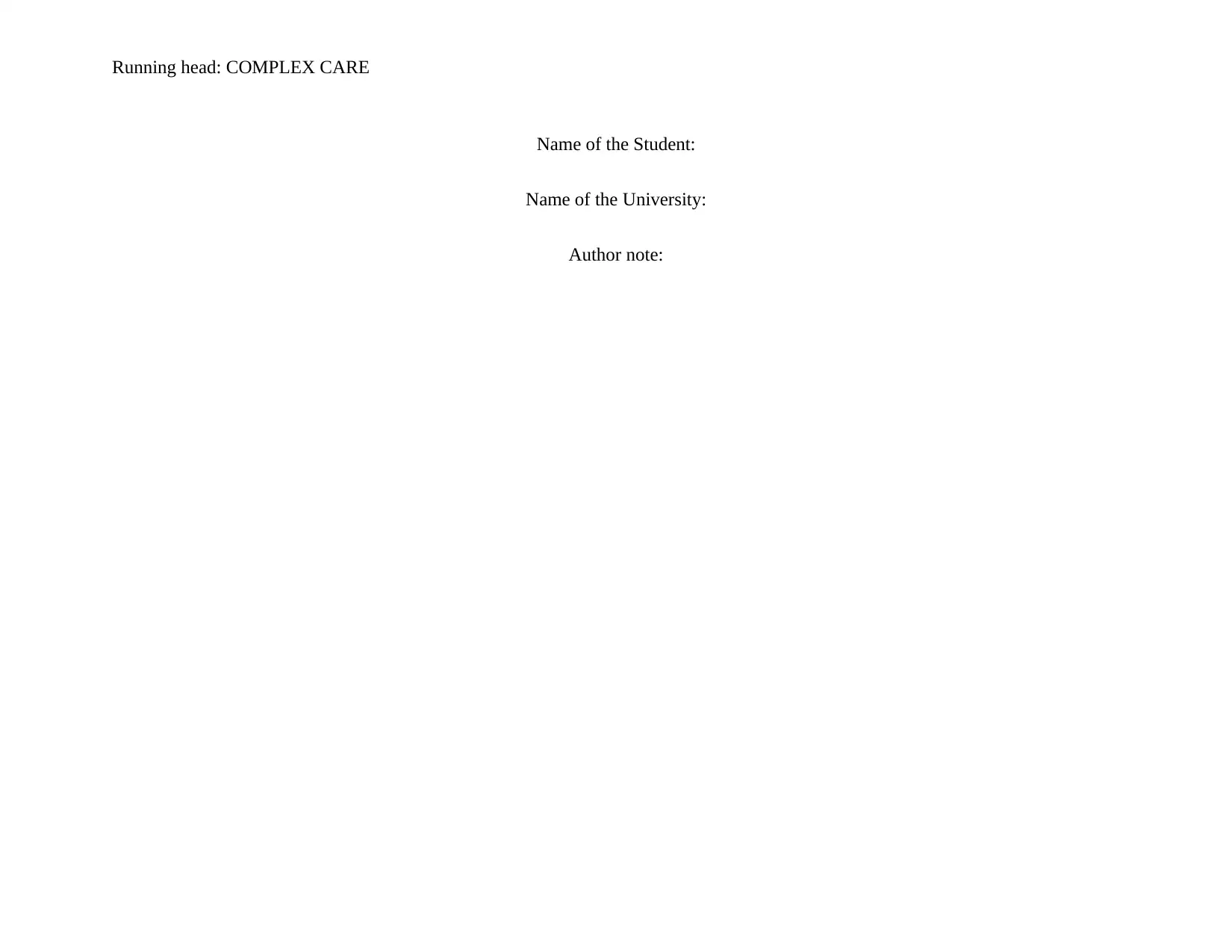
Running head: COMPLEX CARE
Name of the Student:
Name of the University:
Author note:
Name of the Student:
Name of the University:
Author note:
Paraphrase This Document
Need a fresh take? Get an instant paraphrase of this document with our AI Paraphraser
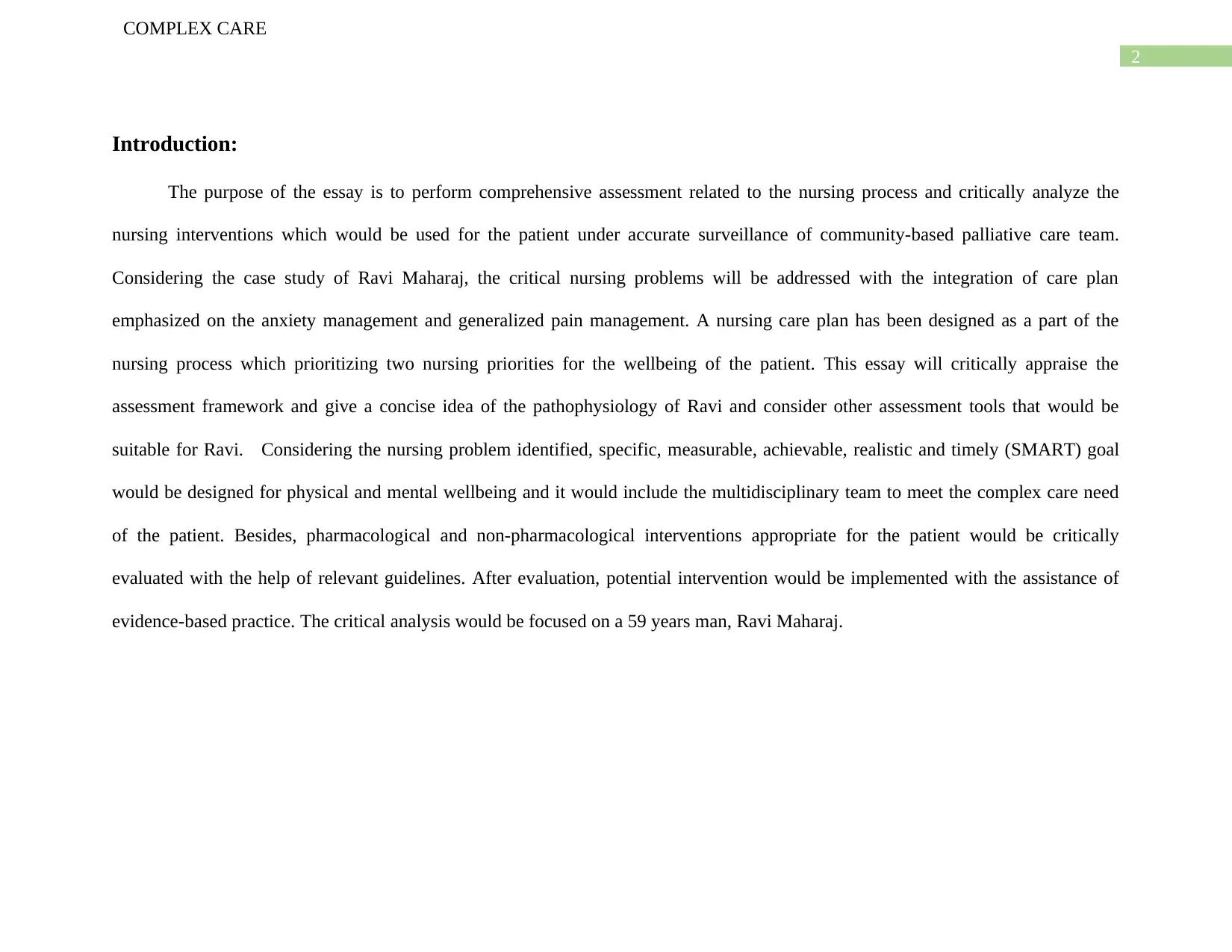
2
COMPLEX CARE
Introduction:
The purpose of the essay is to perform comprehensive assessment related to the nursing process and critically analyze the
nursing interventions which would be used for the patient under accurate surveillance of community-based palliative care team.
Considering the case study of Ravi Maharaj, the critical nursing problems will be addressed with the integration of care plan
emphasized on the anxiety management and generalized pain management. A nursing care plan has been designed as a part of the
nursing process which prioritizing two nursing priorities for the wellbeing of the patient. This essay will critically appraise the
assessment framework and give a concise idea of the pathophysiology of Ravi and consider other assessment tools that would be
suitable for Ravi. Considering the nursing problem identified, specific, measurable, achievable, realistic and timely (SMART) goal
would be designed for physical and mental wellbeing and it would include the multidisciplinary team to meet the complex care need
of the patient. Besides, pharmacological and non-pharmacological interventions appropriate for the patient would be critically
evaluated with the help of relevant guidelines. After evaluation, potential intervention would be implemented with the assistance of
evidence-based practice. The critical analysis would be focused on a 59 years man, Ravi Maharaj.
COMPLEX CARE
Introduction:
The purpose of the essay is to perform comprehensive assessment related to the nursing process and critically analyze the
nursing interventions which would be used for the patient under accurate surveillance of community-based palliative care team.
Considering the case study of Ravi Maharaj, the critical nursing problems will be addressed with the integration of care plan
emphasized on the anxiety management and generalized pain management. A nursing care plan has been designed as a part of the
nursing process which prioritizing two nursing priorities for the wellbeing of the patient. This essay will critically appraise the
assessment framework and give a concise idea of the pathophysiology of Ravi and consider other assessment tools that would be
suitable for Ravi. Considering the nursing problem identified, specific, measurable, achievable, realistic and timely (SMART) goal
would be designed for physical and mental wellbeing and it would include the multidisciplinary team to meet the complex care need
of the patient. Besides, pharmacological and non-pharmacological interventions appropriate for the patient would be critically
evaluated with the help of relevant guidelines. After evaluation, potential intervention would be implemented with the assistance of
evidence-based practice. The critical analysis would be focused on a 59 years man, Ravi Maharaj.
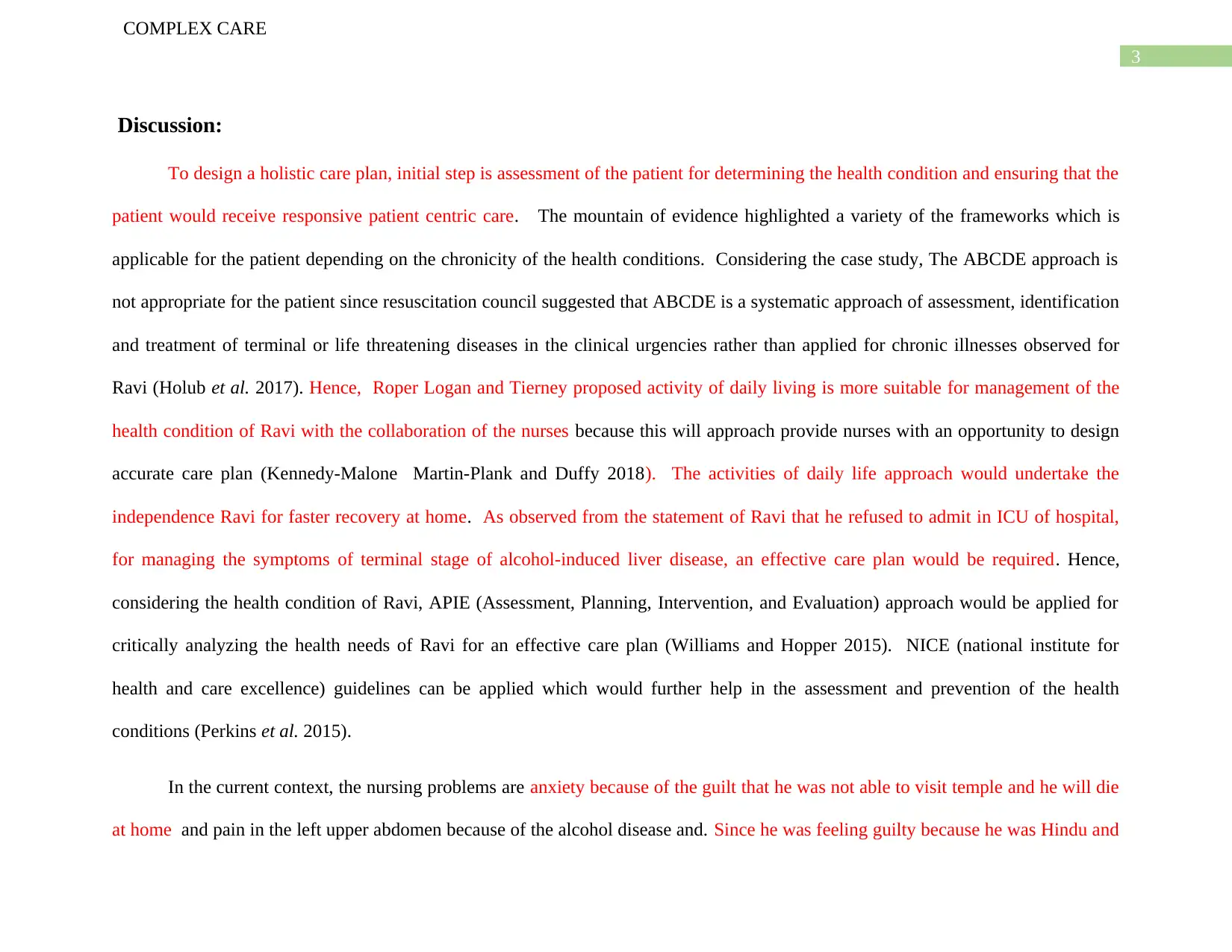
3
COMPLEX CARE
Discussion:
To design a holistic care plan, initial step is assessment of the patient for determining the health condition and ensuring that the
patient would receive responsive patient centric care. The mountain of evidence highlighted a variety of the frameworks which is
applicable for the patient depending on the chronicity of the health conditions. Considering the case study, The ABCDE approach is
not appropriate for the patient since resuscitation council suggested that ABCDE is a systematic approach of assessment, identification
and treatment of terminal or life threatening diseases in the clinical urgencies rather than applied for chronic illnesses observed for
Ravi (Holub et al. 2017). Hence, Roper Logan and Tierney proposed activity of daily living is more suitable for management of the
health condition of Ravi with the collaboration of the nurses because this will approach provide nurses with an opportunity to design
accurate care plan (Kennedy-Malone Martin-Plank and Duffy 2018). The activities of daily life approach would undertake the
independence Ravi for faster recovery at home. As observed from the statement of Ravi that he refused to admit in ICU of hospital,
for managing the symptoms of terminal stage of alcohol-induced liver disease, an effective care plan would be required. Hence,
considering the health condition of Ravi, APIE (Assessment, Planning, Intervention, and Evaluation) approach would be applied for
critically analyzing the health needs of Ravi for an effective care plan (Williams and Hopper 2015). NICE (national institute for
health and care excellence) guidelines can be applied which would further help in the assessment and prevention of the health
conditions (Perkins et al. 2015).
In the current context, the nursing problems are anxiety because of the guilt that he was not able to visit temple and he will die
at home and pain in the left upper abdomen because of the alcohol disease and. Since he was feeling guilty because he was Hindu and
COMPLEX CARE
Discussion:
To design a holistic care plan, initial step is assessment of the patient for determining the health condition and ensuring that the
patient would receive responsive patient centric care. The mountain of evidence highlighted a variety of the frameworks which is
applicable for the patient depending on the chronicity of the health conditions. Considering the case study, The ABCDE approach is
not appropriate for the patient since resuscitation council suggested that ABCDE is a systematic approach of assessment, identification
and treatment of terminal or life threatening diseases in the clinical urgencies rather than applied for chronic illnesses observed for
Ravi (Holub et al. 2017). Hence, Roper Logan and Tierney proposed activity of daily living is more suitable for management of the
health condition of Ravi with the collaboration of the nurses because this will approach provide nurses with an opportunity to design
accurate care plan (Kennedy-Malone Martin-Plank and Duffy 2018). The activities of daily life approach would undertake the
independence Ravi for faster recovery at home. As observed from the statement of Ravi that he refused to admit in ICU of hospital,
for managing the symptoms of terminal stage of alcohol-induced liver disease, an effective care plan would be required. Hence,
considering the health condition of Ravi, APIE (Assessment, Planning, Intervention, and Evaluation) approach would be applied for
critically analyzing the health needs of Ravi for an effective care plan (Williams and Hopper 2015). NICE (national institute for
health and care excellence) guidelines can be applied which would further help in the assessment and prevention of the health
conditions (Perkins et al. 2015).
In the current context, the nursing problems are anxiety because of the guilt that he was not able to visit temple and he will die
at home and pain in the left upper abdomen because of the alcohol disease and. Since he was feeling guilty because he was Hindu and
⊘ This is a preview!⊘
Do you want full access?
Subscribe today to unlock all pages.

Trusted by 1+ million students worldwide
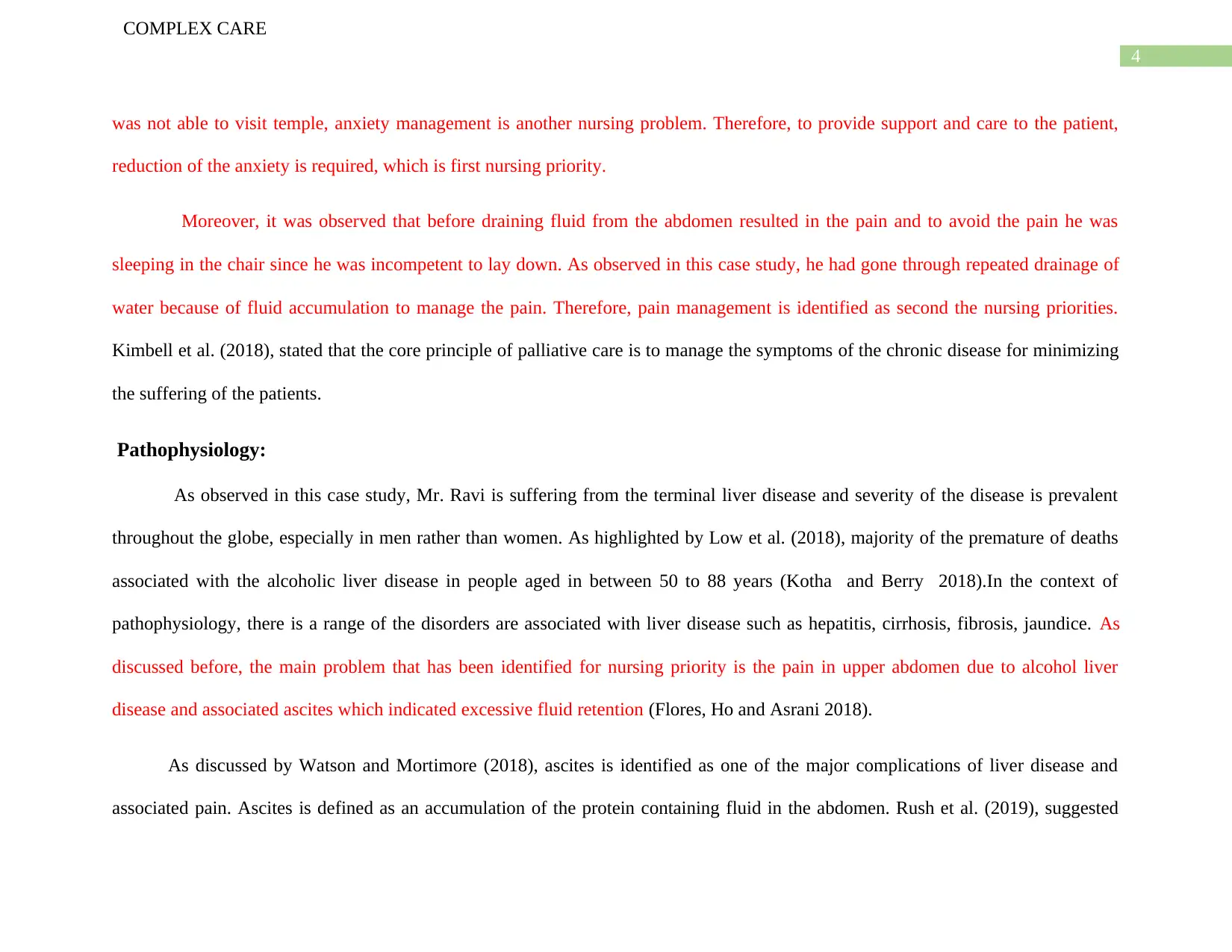
4
COMPLEX CARE
was not able to visit temple, anxiety management is another nursing problem. Therefore, to provide support and care to the patient,
reduction of the anxiety is required, which is first nursing priority.
Moreover, it was observed that before draining fluid from the abdomen resulted in the pain and to avoid the pain he was
sleeping in the chair since he was incompetent to lay down. As observed in this case study, he had gone through repeated drainage of
water because of fluid accumulation to manage the pain. Therefore, pain management is identified as second the nursing priorities.
Kimbell et al. (2018), stated that the core principle of palliative care is to manage the symptoms of the chronic disease for minimizing
the suffering of the patients.
Pathophysiology:
As observed in this case study, Mr. Ravi is suffering from the terminal liver disease and severity of the disease is prevalent
throughout the globe, especially in men rather than women. As highlighted by Low et al. (2018), majority of the premature of deaths
associated with the alcoholic liver disease in people aged in between 50 to 88 years (Kotha and Berry 2018).In the context of
pathophysiology, there is a range of the disorders are associated with liver disease such as hepatitis, cirrhosis, fibrosis, jaundice. As
discussed before, the main problem that has been identified for nursing priority is the pain in upper abdomen due to alcohol liver
disease and associated ascites which indicated excessive fluid retention (Flores, Ho and Asrani 2018).
As discussed by Watson and Mortimore (2018), ascites is identified as one of the major complications of liver disease and
associated pain. Ascites is defined as an accumulation of the protein containing fluid in the abdomen. Rush et al. (2019), suggested
COMPLEX CARE
was not able to visit temple, anxiety management is another nursing problem. Therefore, to provide support and care to the patient,
reduction of the anxiety is required, which is first nursing priority.
Moreover, it was observed that before draining fluid from the abdomen resulted in the pain and to avoid the pain he was
sleeping in the chair since he was incompetent to lay down. As observed in this case study, he had gone through repeated drainage of
water because of fluid accumulation to manage the pain. Therefore, pain management is identified as second the nursing priorities.
Kimbell et al. (2018), stated that the core principle of palliative care is to manage the symptoms of the chronic disease for minimizing
the suffering of the patients.
Pathophysiology:
As observed in this case study, Mr. Ravi is suffering from the terminal liver disease and severity of the disease is prevalent
throughout the globe, especially in men rather than women. As highlighted by Low et al. (2018), majority of the premature of deaths
associated with the alcoholic liver disease in people aged in between 50 to 88 years (Kotha and Berry 2018).In the context of
pathophysiology, there is a range of the disorders are associated with liver disease such as hepatitis, cirrhosis, fibrosis, jaundice. As
discussed before, the main problem that has been identified for nursing priority is the pain in upper abdomen due to alcohol liver
disease and associated ascites which indicated excessive fluid retention (Flores, Ho and Asrani 2018).
As discussed by Watson and Mortimore (2018), ascites is identified as one of the major complications of liver disease and
associated pain. Ascites is defined as an accumulation of the protein containing fluid in the abdomen. Rush et al. (2019), suggested
Paraphrase This Document
Need a fresh take? Get an instant paraphrase of this document with our AI Paraphraser
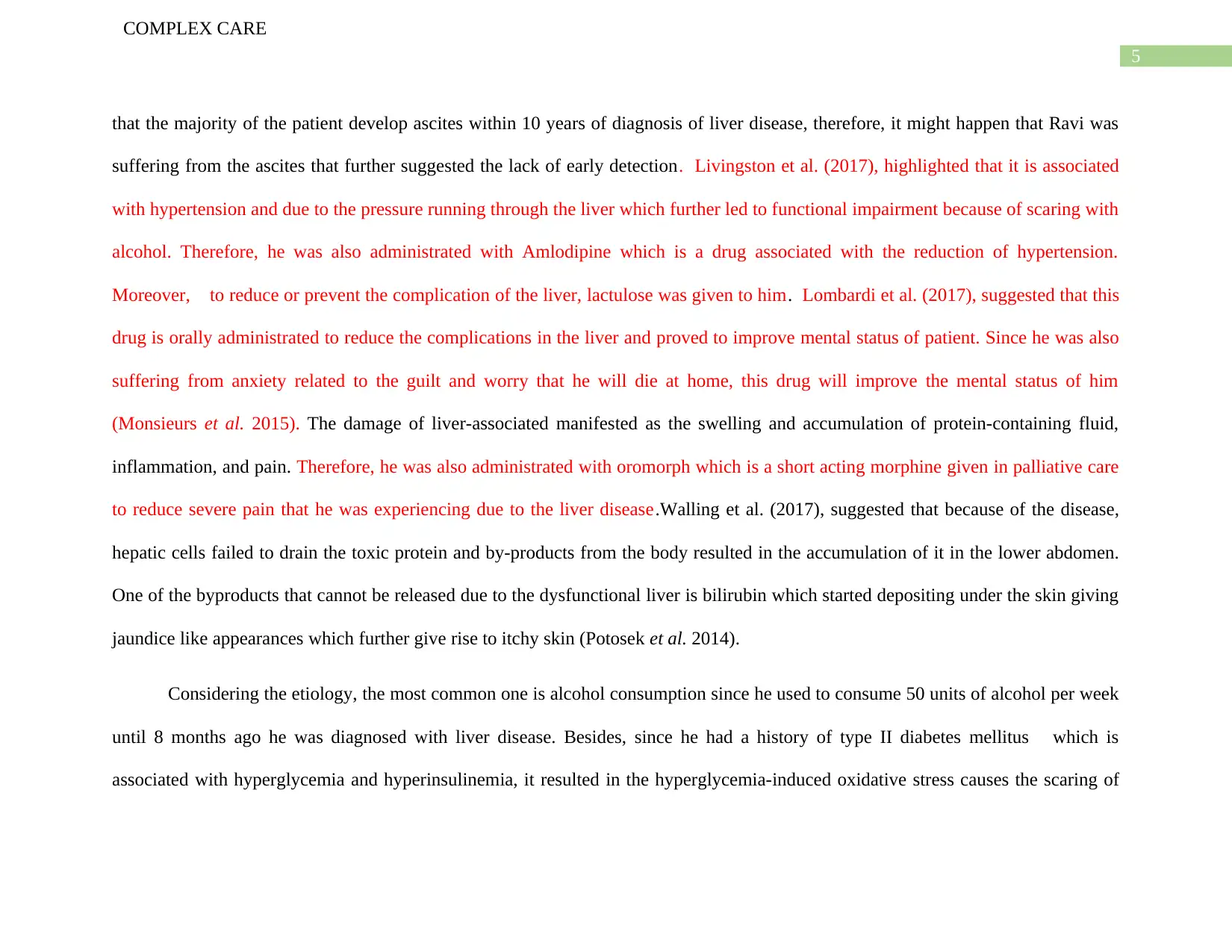
5
COMPLEX CARE
that the majority of the patient develop ascites within 10 years of diagnosis of liver disease, therefore, it might happen that Ravi was
suffering from the ascites that further suggested the lack of early detection. Livingston et al. (2017), highlighted that it is associated
with hypertension and due to the pressure running through the liver which further led to functional impairment because of scaring with
alcohol. Therefore, he was also administrated with Amlodipine which is a drug associated with the reduction of hypertension.
Moreover, to reduce or prevent the complication of the liver, lactulose was given to him. Lombardi et al. (2017), suggested that this
drug is orally administrated to reduce the complications in the liver and proved to improve mental status of patient. Since he was also
suffering from anxiety related to the guilt and worry that he will die at home, this drug will improve the mental status of him
(Monsieurs et al. 2015). The damage of liver-associated manifested as the swelling and accumulation of protein-containing fluid,
inflammation, and pain. Therefore, he was also administrated with oromorph which is a short acting morphine given in palliative care
to reduce severe pain that he was experiencing due to the liver disease.Walling et al. (2017), suggested that because of the disease,
hepatic cells failed to drain the toxic protein and by-products from the body resulted in the accumulation of it in the lower abdomen.
One of the byproducts that cannot be released due to the dysfunctional liver is bilirubin which started depositing under the skin giving
jaundice like appearances which further give rise to itchy skin (Potosek et al. 2014).
Considering the etiology, the most common one is alcohol consumption since he used to consume 50 units of alcohol per week
until 8 months ago he was diagnosed with liver disease. Besides, since he had a history of type II diabetes mellitus which is
associated with hyperglycemia and hyperinsulinemia, it resulted in the hyperglycemia-induced oxidative stress causes the scaring of
COMPLEX CARE
that the majority of the patient develop ascites within 10 years of diagnosis of liver disease, therefore, it might happen that Ravi was
suffering from the ascites that further suggested the lack of early detection. Livingston et al. (2017), highlighted that it is associated
with hypertension and due to the pressure running through the liver which further led to functional impairment because of scaring with
alcohol. Therefore, he was also administrated with Amlodipine which is a drug associated with the reduction of hypertension.
Moreover, to reduce or prevent the complication of the liver, lactulose was given to him. Lombardi et al. (2017), suggested that this
drug is orally administrated to reduce the complications in the liver and proved to improve mental status of patient. Since he was also
suffering from anxiety related to the guilt and worry that he will die at home, this drug will improve the mental status of him
(Monsieurs et al. 2015). The damage of liver-associated manifested as the swelling and accumulation of protein-containing fluid,
inflammation, and pain. Therefore, he was also administrated with oromorph which is a short acting morphine given in palliative care
to reduce severe pain that he was experiencing due to the liver disease.Walling et al. (2017), suggested that because of the disease,
hepatic cells failed to drain the toxic protein and by-products from the body resulted in the accumulation of it in the lower abdomen.
One of the byproducts that cannot be released due to the dysfunctional liver is bilirubin which started depositing under the skin giving
jaundice like appearances which further give rise to itchy skin (Potosek et al. 2014).
Considering the etiology, the most common one is alcohol consumption since he used to consume 50 units of alcohol per week
until 8 months ago he was diagnosed with liver disease. Besides, since he had a history of type II diabetes mellitus which is
associated with hyperglycemia and hyperinsulinemia, it resulted in the hyperglycemia-induced oxidative stress causes the scaring of
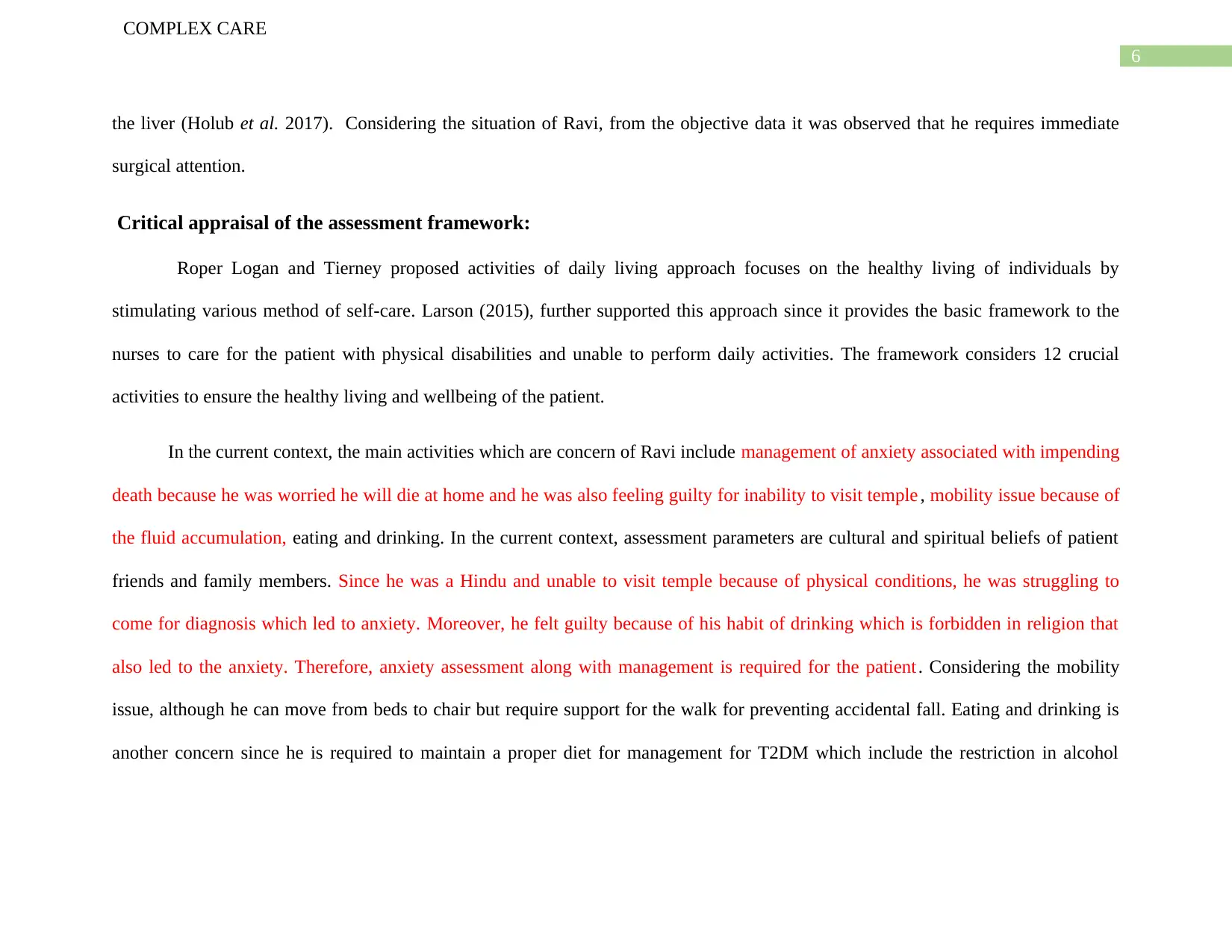
6
COMPLEX CARE
the liver (Holub et al. 2017). Considering the situation of Ravi, from the objective data it was observed that he requires immediate
surgical attention.
Critical appraisal of the assessment framework:
Roper Logan and Tierney proposed activities of daily living approach focuses on the healthy living of individuals by
stimulating various method of self-care. Larson (2015), further supported this approach since it provides the basic framework to the
nurses to care for the patient with physical disabilities and unable to perform daily activities. The framework considers 12 crucial
activities to ensure the healthy living and wellbeing of the patient.
In the current context, the main activities which are concern of Ravi include management of anxiety associated with impending
death because he was worried he will die at home and he was also feeling guilty for inability to visit temple , mobility issue because of
the fluid accumulation, eating and drinking. In the current context, assessment parameters are cultural and spiritual beliefs of patient
friends and family members. Since he was a Hindu and unable to visit temple because of physical conditions, he was struggling to
come for diagnosis which led to anxiety. Moreover, he felt guilty because of his habit of drinking which is forbidden in religion that
also led to the anxiety. Therefore, anxiety assessment along with management is required for the patient. Considering the mobility
issue, although he can move from beds to chair but require support for the walk for preventing accidental fall. Eating and drinking is
another concern since he is required to maintain a proper diet for management for T2DM which include the restriction in alcohol
COMPLEX CARE
the liver (Holub et al. 2017). Considering the situation of Ravi, from the objective data it was observed that he requires immediate
surgical attention.
Critical appraisal of the assessment framework:
Roper Logan and Tierney proposed activities of daily living approach focuses on the healthy living of individuals by
stimulating various method of self-care. Larson (2015), further supported this approach since it provides the basic framework to the
nurses to care for the patient with physical disabilities and unable to perform daily activities. The framework considers 12 crucial
activities to ensure the healthy living and wellbeing of the patient.
In the current context, the main activities which are concern of Ravi include management of anxiety associated with impending
death because he was worried he will die at home and he was also feeling guilty for inability to visit temple , mobility issue because of
the fluid accumulation, eating and drinking. In the current context, assessment parameters are cultural and spiritual beliefs of patient
friends and family members. Since he was a Hindu and unable to visit temple because of physical conditions, he was struggling to
come for diagnosis which led to anxiety. Moreover, he felt guilty because of his habit of drinking which is forbidden in religion that
also led to the anxiety. Therefore, anxiety assessment along with management is required for the patient. Considering the mobility
issue, although he can move from beds to chair but require support for the walk for preventing accidental fall. Eating and drinking is
another concern since he is required to maintain a proper diet for management for T2DM which include the restriction in alcohol
⊘ This is a preview!⊘
Do you want full access?
Subscribe today to unlock all pages.

Trusted by 1+ million students worldwide
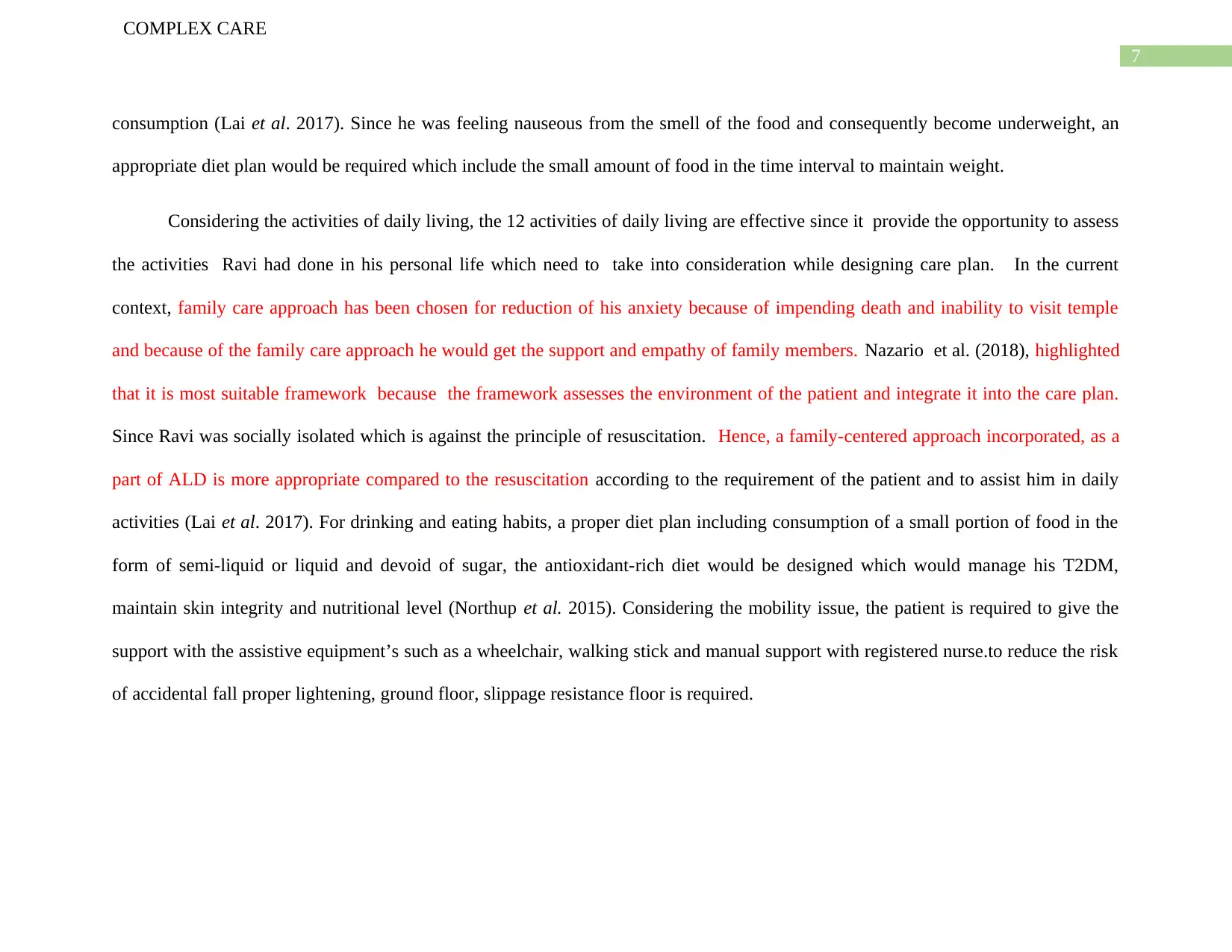
7
COMPLEX CARE
consumption (Lai et al. 2017). Since he was feeling nauseous from the smell of the food and consequently become underweight, an
appropriate diet plan would be required which include the small amount of food in the time interval to maintain weight.
Considering the activities of daily living, the 12 activities of daily living are effective since it provide the opportunity to assess
the activities Ravi had done in his personal life which need to take into consideration while designing care plan. In the current
context, family care approach has been chosen for reduction of his anxiety because of impending death and inability to visit temple
and because of the family care approach he would get the support and empathy of family members. Nazario et al. (2018), highlighted
that it is most suitable framework because the framework assesses the environment of the patient and integrate it into the care plan.
Since Ravi was socially isolated which is against the principle of resuscitation. Hence, a family-centered approach incorporated, as a
part of ALD is more appropriate compared to the resuscitation according to the requirement of the patient and to assist him in daily
activities (Lai et al. 2017). For drinking and eating habits, a proper diet plan including consumption of a small portion of food in the
form of semi-liquid or liquid and devoid of sugar, the antioxidant-rich diet would be designed which would manage his T2DM,
maintain skin integrity and nutritional level (Northup et al. 2015). Considering the mobility issue, the patient is required to give the
support with the assistive equipment’s such as a wheelchair, walking stick and manual support with registered nurse.to reduce the risk
of accidental fall proper lightening, ground floor, slippage resistance floor is required.
COMPLEX CARE
consumption (Lai et al. 2017). Since he was feeling nauseous from the smell of the food and consequently become underweight, an
appropriate diet plan would be required which include the small amount of food in the time interval to maintain weight.
Considering the activities of daily living, the 12 activities of daily living are effective since it provide the opportunity to assess
the activities Ravi had done in his personal life which need to take into consideration while designing care plan. In the current
context, family care approach has been chosen for reduction of his anxiety because of impending death and inability to visit temple
and because of the family care approach he would get the support and empathy of family members. Nazario et al. (2018), highlighted
that it is most suitable framework because the framework assesses the environment of the patient and integrate it into the care plan.
Since Ravi was socially isolated which is against the principle of resuscitation. Hence, a family-centered approach incorporated, as a
part of ALD is more appropriate compared to the resuscitation according to the requirement of the patient and to assist him in daily
activities (Lai et al. 2017). For drinking and eating habits, a proper diet plan including consumption of a small portion of food in the
form of semi-liquid or liquid and devoid of sugar, the antioxidant-rich diet would be designed which would manage his T2DM,
maintain skin integrity and nutritional level (Northup et al. 2015). Considering the mobility issue, the patient is required to give the
support with the assistive equipment’s such as a wheelchair, walking stick and manual support with registered nurse.to reduce the risk
of accidental fall proper lightening, ground floor, slippage resistance floor is required.
Paraphrase This Document
Need a fresh take? Get an instant paraphrase of this document with our AI Paraphraser
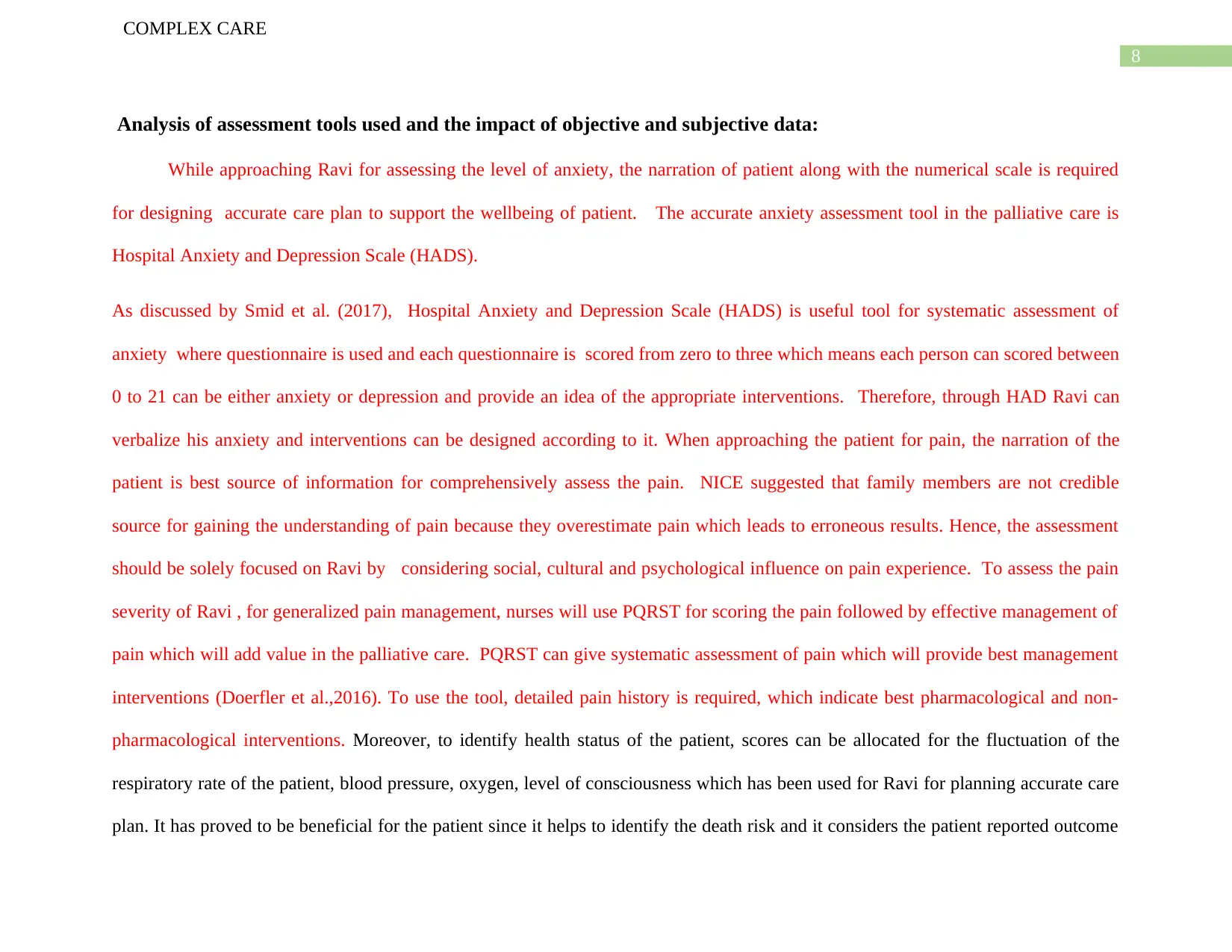
8
COMPLEX CARE
Analysis of assessment tools used and the impact of objective and subjective data:
While approaching Ravi for assessing the level of anxiety, the narration of patient along with the numerical scale is required
for designing accurate care plan to support the wellbeing of patient. The accurate anxiety assessment tool in the palliative care is
Hospital Anxiety and Depression Scale (HADS).
As discussed by Smid et al. (2017), Hospital Anxiety and Depression Scale (HADS) is useful tool for systematic assessment of
anxiety where questionnaire is used and each questionnaire is scored from zero to three which means each person can scored between
0 to 21 can be either anxiety or depression and provide an idea of the appropriate interventions. Therefore, through HAD Ravi can
verbalize his anxiety and interventions can be designed according to it. When approaching the patient for pain, the narration of the
patient is best source of information for comprehensively assess the pain. NICE suggested that family members are not credible
source for gaining the understanding of pain because they overestimate pain which leads to erroneous results. Hence, the assessment
should be solely focused on Ravi by considering social, cultural and psychological influence on pain experience. To assess the pain
severity of Ravi , for generalized pain management, nurses will use PQRST for scoring the pain followed by effective management of
pain which will add value in the palliative care. PQRST can give systematic assessment of pain which will provide best management
interventions (Doerfler et al.,2016). To use the tool, detailed pain history is required, which indicate best pharmacological and non-
pharmacological interventions. Moreover, to identify health status of the patient, scores can be allocated for the fluctuation of the
respiratory rate of the patient, blood pressure, oxygen, level of consciousness which has been used for Ravi for planning accurate care
plan. It has proved to be beneficial for the patient since it helps to identify the death risk and it considers the patient reported outcome
COMPLEX CARE
Analysis of assessment tools used and the impact of objective and subjective data:
While approaching Ravi for assessing the level of anxiety, the narration of patient along with the numerical scale is required
for designing accurate care plan to support the wellbeing of patient. The accurate anxiety assessment tool in the palliative care is
Hospital Anxiety and Depression Scale (HADS).
As discussed by Smid et al. (2017), Hospital Anxiety and Depression Scale (HADS) is useful tool for systematic assessment of
anxiety where questionnaire is used and each questionnaire is scored from zero to three which means each person can scored between
0 to 21 can be either anxiety or depression and provide an idea of the appropriate interventions. Therefore, through HAD Ravi can
verbalize his anxiety and interventions can be designed according to it. When approaching the patient for pain, the narration of the
patient is best source of information for comprehensively assess the pain. NICE suggested that family members are not credible
source for gaining the understanding of pain because they overestimate pain which leads to erroneous results. Hence, the assessment
should be solely focused on Ravi by considering social, cultural and psychological influence on pain experience. To assess the pain
severity of Ravi , for generalized pain management, nurses will use PQRST for scoring the pain followed by effective management of
pain which will add value in the palliative care. PQRST can give systematic assessment of pain which will provide best management
interventions (Doerfler et al.,2016). To use the tool, detailed pain history is required, which indicate best pharmacological and non-
pharmacological interventions. Moreover, to identify health status of the patient, scores can be allocated for the fluctuation of the
respiratory rate of the patient, blood pressure, oxygen, level of consciousness which has been used for Ravi for planning accurate care
plan. It has proved to be beneficial for the patient since it helps to identify the death risk and it considers the patient reported outcome
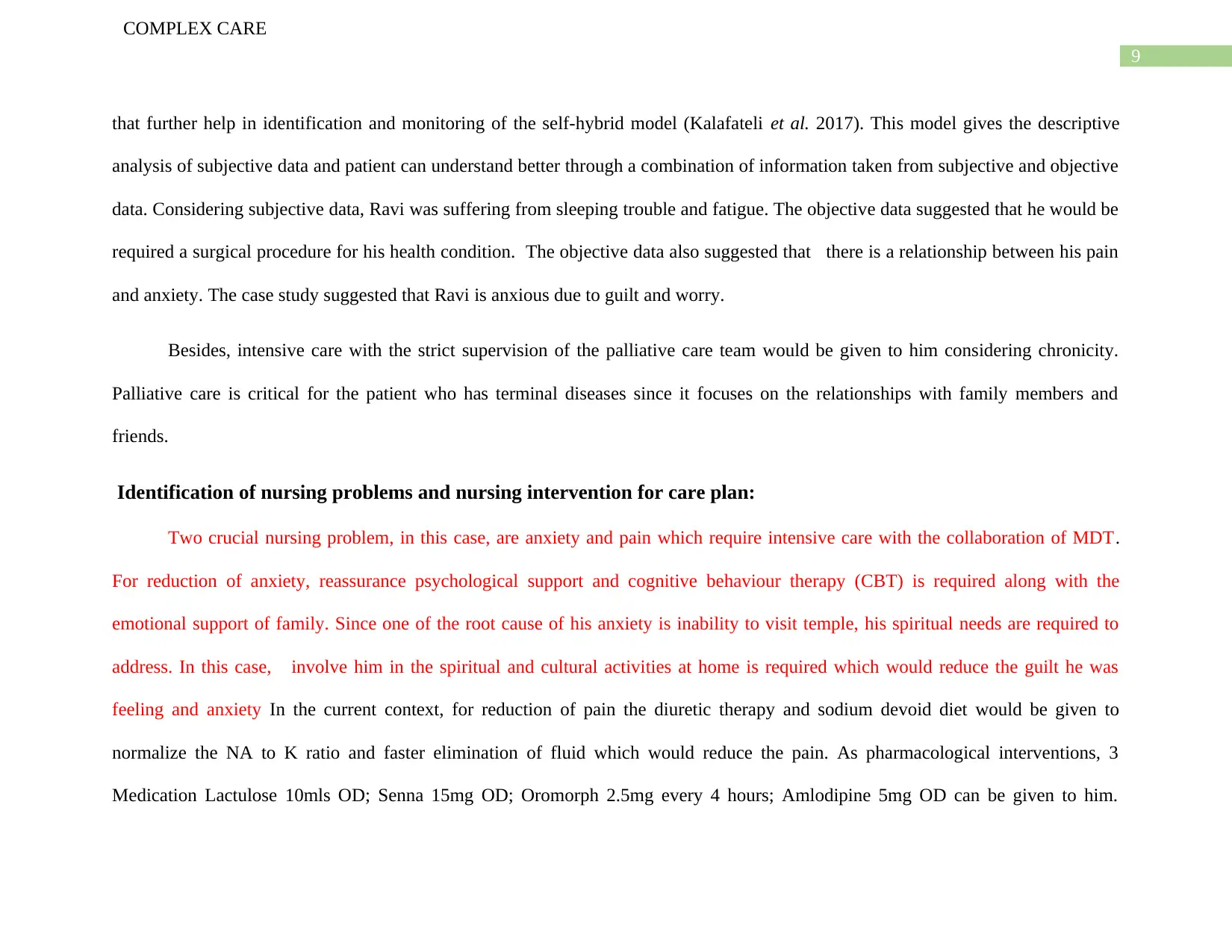
9
COMPLEX CARE
that further help in identification and monitoring of the self-hybrid model (Kalafateli et al. 2017). This model gives the descriptive
analysis of subjective data and patient can understand better through a combination of information taken from subjective and objective
data. Considering subjective data, Ravi was suffering from sleeping trouble and fatigue. The objective data suggested that he would be
required a surgical procedure for his health condition. The objective data also suggested that there is a relationship between his pain
and anxiety. The case study suggested that Ravi is anxious due to guilt and worry.
Besides, intensive care with the strict supervision of the palliative care team would be given to him considering chronicity.
Palliative care is critical for the patient who has terminal diseases since it focuses on the relationships with family members and
friends.
Identification of nursing problems and nursing intervention for care plan:
Two crucial nursing problem, in this case, are anxiety and pain which require intensive care with the collaboration of MDT.
For reduction of anxiety, reassurance psychological support and cognitive behaviour therapy (CBT) is required along with the
emotional support of family. Since one of the root cause of his anxiety is inability to visit temple, his spiritual needs are required to
address. In this case, involve him in the spiritual and cultural activities at home is required which would reduce the guilt he was
feeling and anxiety In the current context, for reduction of pain the diuretic therapy and sodium devoid diet would be given to
normalize the NA to K ratio and faster elimination of fluid which would reduce the pain. As pharmacological interventions, 3
Medication Lactulose 10mls OD; Senna 15mg OD; Oromorph 2.5mg every 4 hours; Amlodipine 5mg OD can be given to him.
COMPLEX CARE
that further help in identification and monitoring of the self-hybrid model (Kalafateli et al. 2017). This model gives the descriptive
analysis of subjective data and patient can understand better through a combination of information taken from subjective and objective
data. Considering subjective data, Ravi was suffering from sleeping trouble and fatigue. The objective data suggested that he would be
required a surgical procedure for his health condition. The objective data also suggested that there is a relationship between his pain
and anxiety. The case study suggested that Ravi is anxious due to guilt and worry.
Besides, intensive care with the strict supervision of the palliative care team would be given to him considering chronicity.
Palliative care is critical for the patient who has terminal diseases since it focuses on the relationships with family members and
friends.
Identification of nursing problems and nursing intervention for care plan:
Two crucial nursing problem, in this case, are anxiety and pain which require intensive care with the collaboration of MDT.
For reduction of anxiety, reassurance psychological support and cognitive behaviour therapy (CBT) is required along with the
emotional support of family. Since one of the root cause of his anxiety is inability to visit temple, his spiritual needs are required to
address. In this case, involve him in the spiritual and cultural activities at home is required which would reduce the guilt he was
feeling and anxiety In the current context, for reduction of pain the diuretic therapy and sodium devoid diet would be given to
normalize the NA to K ratio and faster elimination of fluid which would reduce the pain. As pharmacological interventions, 3
Medication Lactulose 10mls OD; Senna 15mg OD; Oromorph 2.5mg every 4 hours; Amlodipine 5mg OD can be given to him.
⊘ This is a preview!⊘
Do you want full access?
Subscribe today to unlock all pages.

Trusted by 1+ million students worldwide
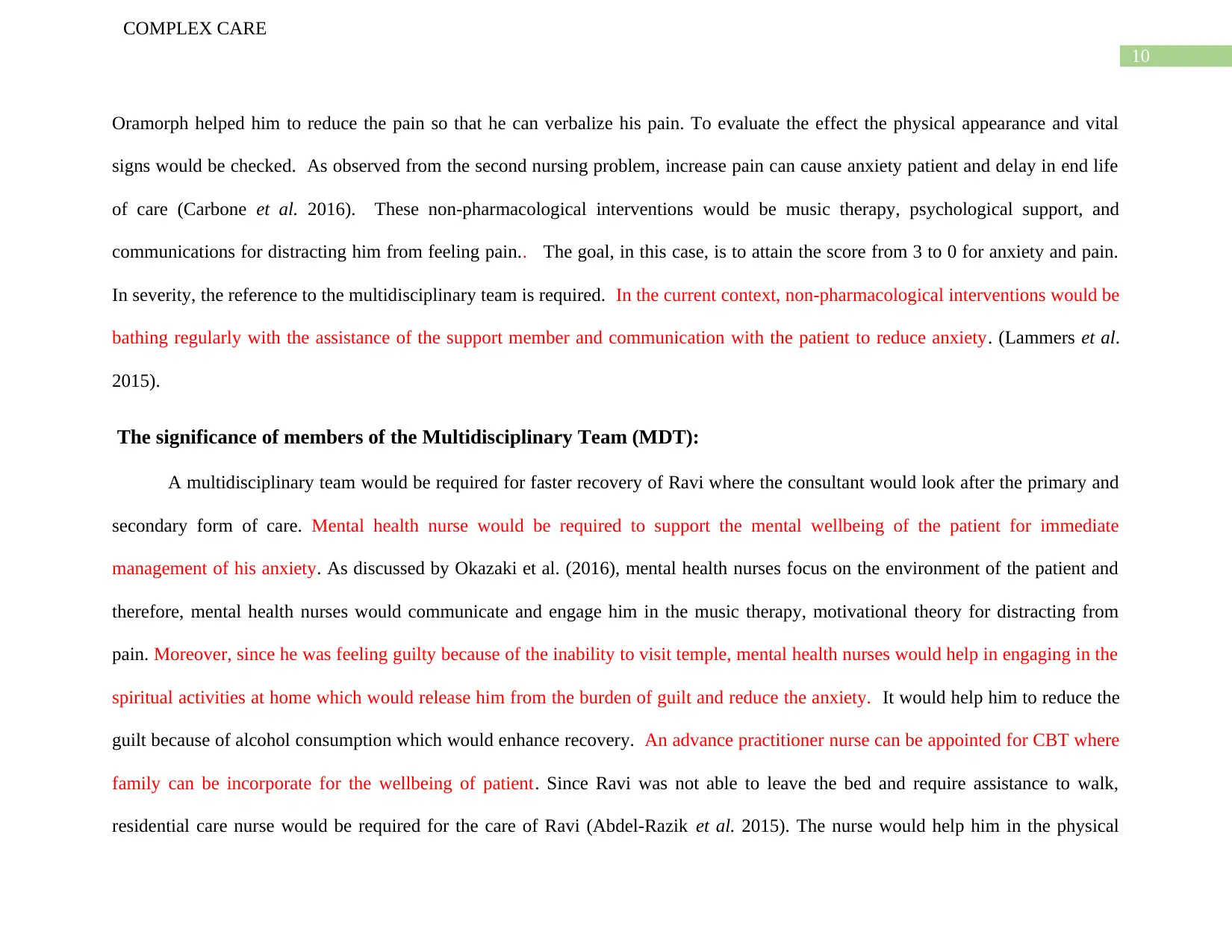
10
COMPLEX CARE
Oramorph helped him to reduce the pain so that he can verbalize his pain. To evaluate the effect the physical appearance and vital
signs would be checked. As observed from the second nursing problem, increase pain can cause anxiety patient and delay in end life
of care (Carbone et al. 2016). These non-pharmacological interventions would be music therapy, psychological support, and
communications for distracting him from feeling pain.. The goal, in this case, is to attain the score from 3 to 0 for anxiety and pain.
In severity, the reference to the multidisciplinary team is required. In the current context, non-pharmacological interventions would be
bathing regularly with the assistance of the support member and communication with the patient to reduce anxiety. (Lammers et al.
2015).
The significance of members of the Multidisciplinary Team (MDT):
A multidisciplinary team would be required for faster recovery of Ravi where the consultant would look after the primary and
secondary form of care. Mental health nurse would be required to support the mental wellbeing of the patient for immediate
management of his anxiety. As discussed by Okazaki et al. (2016), mental health nurses focus on the environment of the patient and
therefore, mental health nurses would communicate and engage him in the music therapy, motivational theory for distracting from
pain. Moreover, since he was feeling guilty because of the inability to visit temple, mental health nurses would help in engaging in the
spiritual activities at home which would release him from the burden of guilt and reduce the anxiety. It would help him to reduce the
guilt because of alcohol consumption which would enhance recovery. An advance practitioner nurse can be appointed for CBT where
family can be incorporate for the wellbeing of patient. Since Ravi was not able to leave the bed and require assistance to walk,
residential care nurse would be required for the care of Ravi (Abdel-Razik et al. 2015). The nurse would help him in the physical
COMPLEX CARE
Oramorph helped him to reduce the pain so that he can verbalize his pain. To evaluate the effect the physical appearance and vital
signs would be checked. As observed from the second nursing problem, increase pain can cause anxiety patient and delay in end life
of care (Carbone et al. 2016). These non-pharmacological interventions would be music therapy, psychological support, and
communications for distracting him from feeling pain.. The goal, in this case, is to attain the score from 3 to 0 for anxiety and pain.
In severity, the reference to the multidisciplinary team is required. In the current context, non-pharmacological interventions would be
bathing regularly with the assistance of the support member and communication with the patient to reduce anxiety. (Lammers et al.
2015).
The significance of members of the Multidisciplinary Team (MDT):
A multidisciplinary team would be required for faster recovery of Ravi where the consultant would look after the primary and
secondary form of care. Mental health nurse would be required to support the mental wellbeing of the patient for immediate
management of his anxiety. As discussed by Okazaki et al. (2016), mental health nurses focus on the environment of the patient and
therefore, mental health nurses would communicate and engage him in the music therapy, motivational theory for distracting from
pain. Moreover, since he was feeling guilty because of the inability to visit temple, mental health nurses would help in engaging in the
spiritual activities at home which would release him from the burden of guilt and reduce the anxiety. It would help him to reduce the
guilt because of alcohol consumption which would enhance recovery. An advance practitioner nurse can be appointed for CBT where
family can be incorporate for the wellbeing of patient. Since Ravi was not able to leave the bed and require assistance to walk,
residential care nurse would be required for the care of Ravi (Abdel-Razik et al. 2015). The nurse would help him in the physical
Paraphrase This Document
Need a fresh take? Get an instant paraphrase of this document with our AI Paraphraser
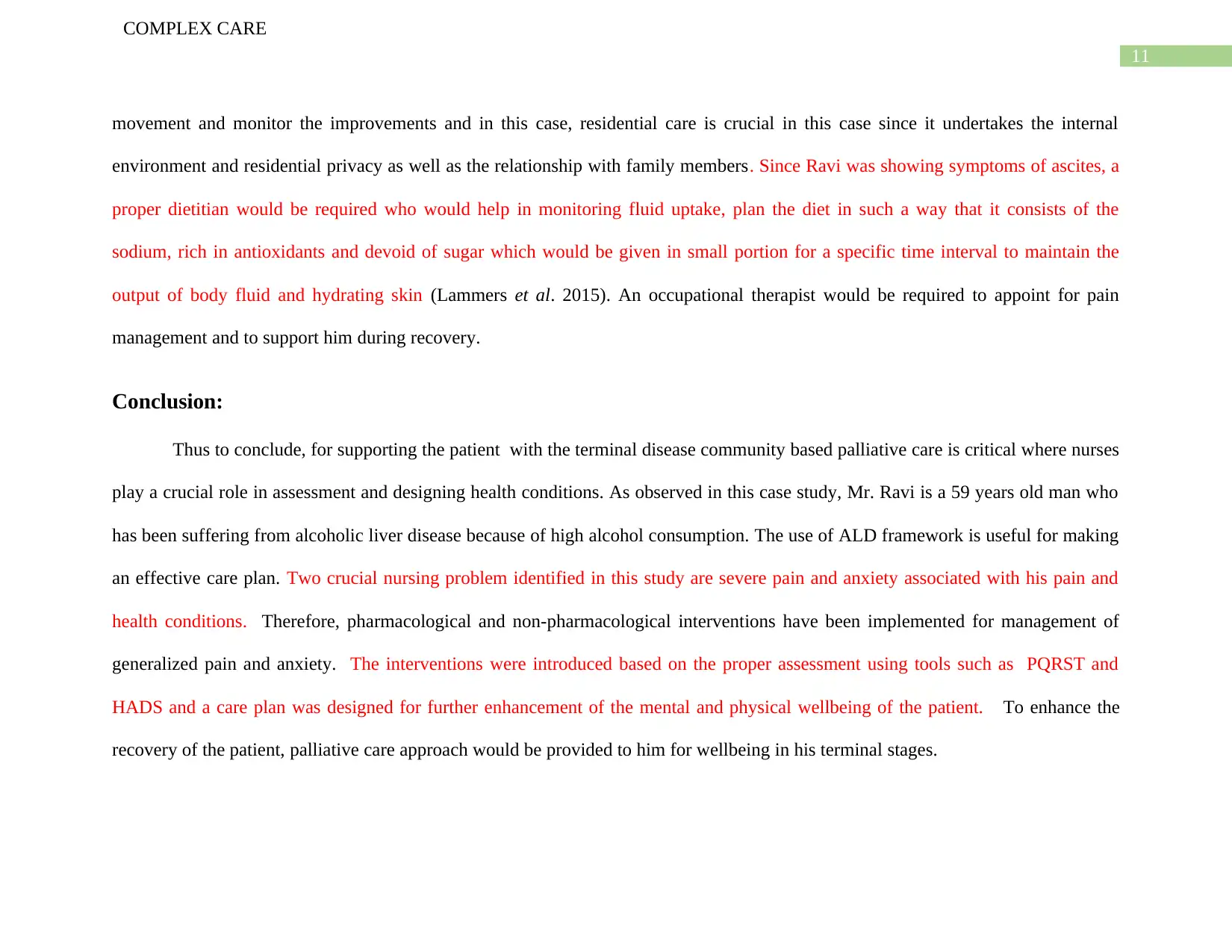
11
COMPLEX CARE
movement and monitor the improvements and in this case, residential care is crucial in this case since it undertakes the internal
environment and residential privacy as well as the relationship with family members. Since Ravi was showing symptoms of ascites, a
proper dietitian would be required who would help in monitoring fluid uptake, plan the diet in such a way that it consists of the
sodium, rich in antioxidants and devoid of sugar which would be given in small portion for a specific time interval to maintain the
output of body fluid and hydrating skin (Lammers et al. 2015). An occupational therapist would be required to appoint for pain
management and to support him during recovery.
Conclusion:
Thus to conclude, for supporting the patient with the terminal disease community based palliative care is critical where nurses
play a crucial role in assessment and designing health conditions. As observed in this case study, Mr. Ravi is a 59 years old man who
has been suffering from alcoholic liver disease because of high alcohol consumption. The use of ALD framework is useful for making
an effective care plan. Two crucial nursing problem identified in this study are severe pain and anxiety associated with his pain and
health conditions. Therefore, pharmacological and non-pharmacological interventions have been implemented for management of
generalized pain and anxiety. The interventions were introduced based on the proper assessment using tools such as PQRST and
HADS and a care plan was designed for further enhancement of the mental and physical wellbeing of the patient. To enhance the
recovery of the patient, palliative care approach would be provided to him for wellbeing in his terminal stages.
COMPLEX CARE
movement and monitor the improvements and in this case, residential care is crucial in this case since it undertakes the internal
environment and residential privacy as well as the relationship with family members. Since Ravi was showing symptoms of ascites, a
proper dietitian would be required who would help in monitoring fluid uptake, plan the diet in such a way that it consists of the
sodium, rich in antioxidants and devoid of sugar which would be given in small portion for a specific time interval to maintain the
output of body fluid and hydrating skin (Lammers et al. 2015). An occupational therapist would be required to appoint for pain
management and to support him during recovery.
Conclusion:
Thus to conclude, for supporting the patient with the terminal disease community based palliative care is critical where nurses
play a crucial role in assessment and designing health conditions. As observed in this case study, Mr. Ravi is a 59 years old man who
has been suffering from alcoholic liver disease because of high alcohol consumption. The use of ALD framework is useful for making
an effective care plan. Two crucial nursing problem identified in this study are severe pain and anxiety associated with his pain and
health conditions. Therefore, pharmacological and non-pharmacological interventions have been implemented for management of
generalized pain and anxiety. The interventions were introduced based on the proper assessment using tools such as PQRST and
HADS and a care plan was designed for further enhancement of the mental and physical wellbeing of the patient. To enhance the
recovery of the patient, palliative care approach would be provided to him for wellbeing in his terminal stages.
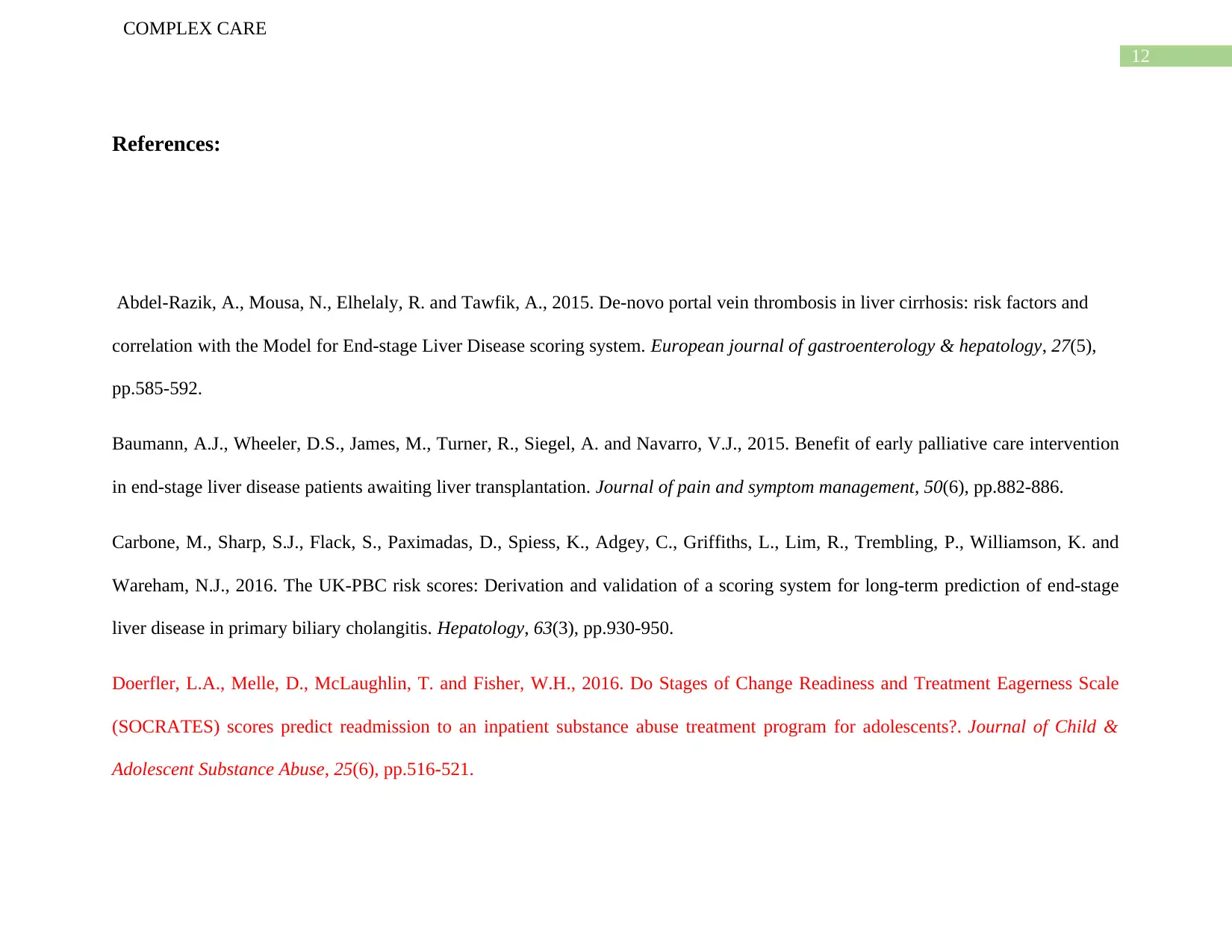
12
COMPLEX CARE
References:
Abdel-Razik, A., Mousa, N., Elhelaly, R. and Tawfik, A., 2015. De-novo portal vein thrombosis in liver cirrhosis: risk factors and
correlation with the Model for End-stage Liver Disease scoring system. European journal of gastroenterology & hepatology, 27(5),
pp.585-592.
Baumann, A.J., Wheeler, D.S., James, M., Turner, R., Siegel, A. and Navarro, V.J., 2015. Benefit of early palliative care intervention
in end-stage liver disease patients awaiting liver transplantation. Journal of pain and symptom management, 50(6), pp.882-886.
Carbone, M., Sharp, S.J., Flack, S., Paximadas, D., Spiess, K., Adgey, C., Griffiths, L., Lim, R., Trembling, P., Williamson, K. and
Wareham, N.J., 2016. The UK‐PBC risk scores: Derivation and validation of a scoring system for long‐term prediction of end‐stage
liver disease in primary biliary cholangitis. Hepatology, 63(3), pp.930-950.
Doerfler, L.A., Melle, D., McLaughlin, T. and Fisher, W.H., 2016. Do Stages of Change Readiness and Treatment Eagerness Scale
(SOCRATES) scores predict readmission to an inpatient substance abuse treatment program for adolescents?. Journal of Child &
Adolescent Substance Abuse, 25(6), pp.516-521.
COMPLEX CARE
References:
Abdel-Razik, A., Mousa, N., Elhelaly, R. and Tawfik, A., 2015. De-novo portal vein thrombosis in liver cirrhosis: risk factors and
correlation with the Model for End-stage Liver Disease scoring system. European journal of gastroenterology & hepatology, 27(5),
pp.585-592.
Baumann, A.J., Wheeler, D.S., James, M., Turner, R., Siegel, A. and Navarro, V.J., 2015. Benefit of early palliative care intervention
in end-stage liver disease patients awaiting liver transplantation. Journal of pain and symptom management, 50(6), pp.882-886.
Carbone, M., Sharp, S.J., Flack, S., Paximadas, D., Spiess, K., Adgey, C., Griffiths, L., Lim, R., Trembling, P., Williamson, K. and
Wareham, N.J., 2016. The UK‐PBC risk scores: Derivation and validation of a scoring system for long‐term prediction of end‐stage
liver disease in primary biliary cholangitis. Hepatology, 63(3), pp.930-950.
Doerfler, L.A., Melle, D., McLaughlin, T. and Fisher, W.H., 2016. Do Stages of Change Readiness and Treatment Eagerness Scale
(SOCRATES) scores predict readmission to an inpatient substance abuse treatment program for adolescents?. Journal of Child &
Adolescent Substance Abuse, 25(6), pp.516-521.
⊘ This is a preview!⊘
Do you want full access?
Subscribe today to unlock all pages.

Trusted by 1+ million students worldwide
1 out of 27
Related Documents
Your All-in-One AI-Powered Toolkit for Academic Success.
+13062052269
info@desklib.com
Available 24*7 on WhatsApp / Email
![[object Object]](/_next/static/media/star-bottom.7253800d.svg)
Unlock your academic potential
Copyright © 2020–2025 A2Z Services. All Rights Reserved. Developed and managed by ZUCOL.





